Dec 16, 2025
Dec 16, 2025
Where were we? Oh yes, Megha, Connaught Place, Nizamuddin and the likes. If you find me forgetting what I myself wrote, then this is not so surprising. With the speed at which things go, what is surprising is that I remember myself, that combination of two problematic concepts, my - and - self.
So what then is this -my? How do you define what is 'yours' and what is not? Its clearly a concept associated with your sense of self, and a sense of self is defined, if we agree with what we thought earlier, as everything that one is 'not'. Does this mean, then, that possession is a defined bond between one's sense of self, and things that are external to it? Admirable though this logic may be, it has a fatal flaw: if 'I', 'me', and 'myself' is what, in other words, 'I' am not, then how can anything that is not 'mine' by this definition, be 'mine' by possession? 'Mine' and 'me' is an unchanging core that does not age, that does not change, that will not die and that has always lived.
While this may be a philosophical inquest at one level, at another it is 'real' life. The Indian Railways online booking website is a modern-day Darwinian marvel, challenging human evolution and notions of the self as it alternates its hapless subject between bouts of stunned wonder and horrific anticipation. One looks forward to the future. I tactfully didn't tell Megha all this, there was enough to do to pick up the threads of a year or more and make attempts at conversation. Fortunately for both of us, none of us has the patience for long-winded nothings. The 6-hour train to Kota became landscape blurring by in a hum of muted conversation, newly-wed couples in corridors, grey-uniformed staff selling dinner, and small-town stations flickering past in metronomic rhythm. In the Rajdhani, that elite of Indian trains, double layers of tinted glass shield you from the Indian summer, but more than that, from the immediacy of it all. But there is still enough to see, to watch the landscape change slowly from the lush green of the Punjab to the semi-arid land that characterises most of Rajasthan. There is the low line of the Aravalis as a constant backdrop, punctuated by hilltop forts and their crumbling ramparts still commanding the countryside. It's a harsh land breeding a tough people, and the trees gnarl out of the earth, fighting with the elements and each other for every inch of growth and precious water. It's not a beautiful land in the conventional sense of the word, unless beauty is to be found in strength and hardship, an aesthetic whose architecture is strong, at times touching the sublime, but rarely effete as that of the Mughal lords and nobility of later Delhi and Lucknow.
We talk of bric-a-bric and this and that, of universities in India and common faces and names, once again re-building common ground. There's not much to say for the moment except to relive funny stories already told and comment on things that have absolutely no relevance to any of our lives. Megha's accentuating streak of grey in her hair makes her look more distinguished. We pass Ranthambhor Tiger Reserve, the fort hidden away deep in the mountains. The train hasn't stopped since Delhi, and the children next door are getting sleepy. Conversation dies down. I look fixedly out of the window and the hours pass by. Dinner comes, deliciously distinctive railway-food smells that are an institution in themselves. We're halfway through this, arguing over bent spoons and plastic water when the train begins to slow, and there is Kota Junction. There's another railway journey done and now we are in a town I haven't been to before.
Heritage hotels are a growing business in India. Some, like the Udai Vilas Palace at Udaipur, are the ultimate in five-star luxury, while others remain affordable for the traveller on a budget. The Brijraj Bhawan at Kota was and continues to be the residence of the royal family of Kota(h). A large bungalow with an unassuming plan and fa'ade that is considerably reduced in appeal by repeated whitewash and the juxtaposition of strangely-proportioned overhanging balconies, the royal haveli retains a certain old-world luxury in its interiors, with its well-polished teaks, wrought-iron lamps and bathrooms big enough to get lost in. The bungalow overlooks the Chambal river that lessens the heat of the evening somewhat, even when there is no breeze. Megha and I look at the interior with delight and not a little relief. Even travelling in air-conditioned luxury, it's a fine thing to lay down your bags and call someplace home, even if it is for hire. The first thing we ask for, by mutual consent, is a chilled beer. While it arrives, I go to the shower and let the water run over me, rejuvenating, soaking away the day's dust. Life is good, and its going to get better.
Things happen in college and some things stay with you for the rest of your life. Akshay, through little fault of his own, is now called Kota. We meet at a little restaurant close to the hotel where Megha and I are selecting from amongst the rather vapid-sounding fare. The paneer kebabs turn out to be rather good, and then Kota and his wife arrive. Manisha's career resume, at least as far as I know, looks something like this: Ph.D. in Literature from Jodhpur University, wife of Kota and mother of Anahad. Oh yes, and four months pregnant in Paris, France the year on the 31st of December, 2005. The obvious injustice of this summing-up strikes me, but there's little to be done about it for the moment. Dinner passes in a blur of voices and post-beer buzz, we fix up a time for the next day. Megha and I head back to the hotel. Its night.
Megha is an attractive person and its been a nice day, full of activity and new things to see. Till some time back, I'd wiffle and waffle and never get around to popping the question, but this time I just ask. I figure that if I don't I'll regret I didn't the next morning like hell. I'm not sure if she's been asked directly before or not. Either way the thing promises to turn into a potentially long discussion that I don't have the stomach for, and so I roll over and go to sleep, at peace, without any fuss, in the soft confines of a heritage hotel in Kota. The truth shall set you free, they say. I'd also like to add that the truth makes for a good night's sleep.
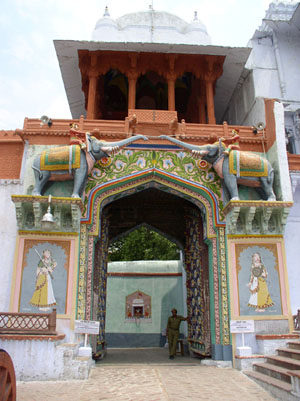 And then the morning comes, a hot stinking day over the Chambal river, and mind you, this is a compliment, the peacocks certainly seem to think there's something for celebration. The ultimate show-off bird, camera-shy and yet wanting, I could swear, to be caught on tape, camera, strut, pose, the works. This is worth a book, though Kota apparently hasn't had much of that honour.
And then the morning comes, a hot stinking day over the Chambal river, and mind you, this is a compliment, the peacocks certainly seem to think there's something for celebration. The ultimate show-off bird, camera-shy and yet wanting, I could swear, to be caught on tape, camera, strut, pose, the works. This is worth a book, though Kota apparently hasn't had much of that honour.
The Lonely Planet pages on Kota dismiss the city in a few short pages. This is fair enough, the few things to see in the city are the Umed Rao Palace, the museum within and the Chambal Gardens with its crocodile pool with no crocodiles. The palace is an unassuming structure in whitewashed plaster, brick and sandstone, the museum inside contains crumbling royal memorabilia artefacts, testimony to a time and life gone by. The museum has a medium-sized central gallery stuffed with royal toys ' a bust of the Maharaja in white plaster that makes him look like an overdressed Englishman, mechanical toys rusting in corners, chairs studded with gems and manuscripts rotting in glass cupboards.
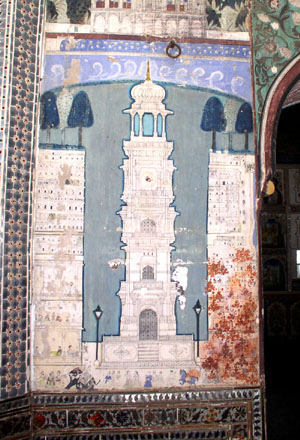 Corridors leading off the main gallery have photographs and paintings, the royal family hunting, posing and doing whatever royals are supposed to do. Kota was a provincial outpost even at the height of Rajputana, and remained so under the British. It suffers from mediocre architecture in a land where standards of this sort are set high by the likes of Jaisalmer and Jodhpur. In all this, there is a detail that stands out, a true elevation drawn on the wall of a lookout post, remarkable in its deviation from the standards of architectural depiction in Rajput art and approximating more to the English standard. Its almost as if an English-trained Indian draughtsman has been engaged, who attempts a fusion of the modern with the traditional, blending tigers, over-scaled foliage and the inevitable side-on human figures with the starkly rendered centrepiece that is remarkable both for its content as for its location, here, in Kota, the back of beyond in the middle of nowhere.
Corridors leading off the main gallery have photographs and paintings, the royal family hunting, posing and doing whatever royals are supposed to do. Kota was a provincial outpost even at the height of Rajputana, and remained so under the British. It suffers from mediocre architecture in a land where standards of this sort are set high by the likes of Jaisalmer and Jodhpur. In all this, there is a detail that stands out, a true elevation drawn on the wall of a lookout post, remarkable in its deviation from the standards of architectural depiction in Rajput art and approximating more to the English standard. Its almost as if an English-trained Indian draughtsman has been engaged, who attempts a fusion of the modern with the traditional, blending tigers, over-scaled foliage and the inevitable side-on human figures with the starkly rendered centrepiece that is remarkable both for its content as for its location, here, in Kota, the back of beyond in the middle of nowhere.
Painting Detail (True Elevation) in Umed Rao Palace, Kota
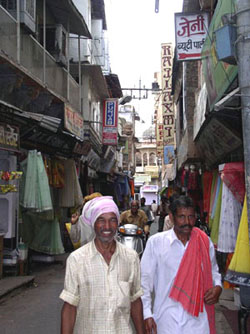 Modern-day Kota has become home to a growing private tuition industry that seems to be fuelling a significant part of the city's economy. These are the impressions we retain in the few hours that we have before we go and see Akshay. There is a tension in the air from the night before and we tolerate each other's company in sullen silence, alleviated by lunch, the heat, and a brief foray to look at Kota saris, fabric woven in cotton crossweave that leaves transparent gaps and promises to be wonderfully light and cool in summer. For the umpteenth time I wonder why these things don't come in sizes and shapes for men, and why when they do, its for a price all out of proportion to the work that goes into them.
Modern-day Kota has become home to a growing private tuition industry that seems to be fuelling a significant part of the city's economy. These are the impressions we retain in the few hours that we have before we go and see Akshay. There is a tension in the air from the night before and we tolerate each other's company in sullen silence, alleviated by lunch, the heat, and a brief foray to look at Kota saris, fabric woven in cotton crossweave that leaves transparent gaps and promises to be wonderfully light and cool in summer. For the umpteenth time I wonder why these things don't come in sizes and shapes for men, and why when they do, its for a price all out of proportion to the work that goes into them.
Dinner at Akshay's is a magnificent affair of traditional Rajasthani fare, with the family and helpers ladling out helping after helping that threatens to leave one gasping for breath from the spice, the oil and the heat as much as for its excellent taste. Remembered lessons in formal behaviour come back as dinner plays itself out, an elaborate ritual of host-guest responsibilities and shifting roles, a pantomime where everyone has a part to play and set things to say and do. It's an intricate game where success is measured by many things and honour of self and family balances delicately between too much and too little. We're supposed to leave for Bundi the next morning, and Akshay as usual, his magnanimity overcoming practicality, makes plans for leaving at 5 am that are quickly dashed by the pragmatics of family, relatives and the occasion. Simply put, ditching 200 guests for a pleasure trip to a palace with your friends (whom no one has ever seen) takes a braver soul, or one more foolhardy, than any of us is. Megha and I catch a cab back to Brijraj Palace. We've both had a full day from the heat and the socialising and there's not much to be done before bed.
Another morning, and there's a taxi that waits for us outside the hotel at 7 am in the morning as we set out for Jhalawar. This is the site of a Sun Temple, our source of information being once again Lonely Planet. This is also a forced excursion in some ways, waiting for Akshay to fulfil his family responsibilities so we can go to Bundi together the next day. He's thankfully shelved all notions of leaving today but that means we have to create work for ourselves, so to speak, and pass another day in and around Kota.
The cabbie is completely unprepared for Megha, who one might have mentioned before can be completely cute. She sits in front with him, and for a while I worry about whether he can drive straight under what is obviously such a powerful influence sitting not two feet away from him. Still, I have the whole back seat to myself so there's not much to complain about. The road to Jhalawar is mostly fine and typical Rajasthan rolls by. We stop for tea and delicious poha at a middlish town, and get appropriately stared at. I think I need to stop hanging out in shorts every now and then, and Megha, always gets looked at by all the men and most of the women. We stop at a bus terminus to pick up water, and by now the cabbie is entertaining thoughts of running away with her. What does he plan to with the irritant in the back seat, I wonder. What would I have done? The rest of the road trip passes in this delicious play of subtle innuendo and little villages and soon Jhalawar is upon us, a medium-sized town enclosed within ramparts in good condition, narrow streets with people on them. Our car blazes through and I feel vaguely like a politician visiting his people might have.
Except that this politician is dressed in a faded t-shirt and really baggy shorts.
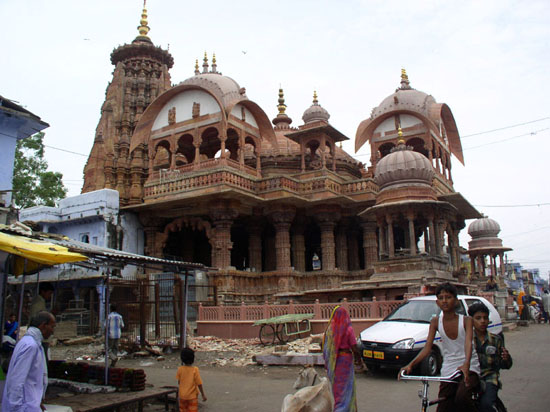
The Sun Temple at Jhalawar, amazingly, is a living temple with an active congregation that today consists mostly of women, chanting away inside as we look around and take pictures. The sculpture on the walls, ceiling and columns, while profuse, is just above ordinary in its workmanship. On the other hand, maybe I've been spoilt by Konark and Bhuvaneswar. The locals seem certainly proud, and one man offers to show me what he calls a 'box'. It turns out to be an erotic carving on one side. I tell him that there are much better at Konark, in quality and quantity, and suggest he go look for himself. There is little other direct local contact. Megha wanders around as I debate whether to follow her, or to swing around the other side and meet her coming head on. These are delicate issues that assume incredible importance in the course of a day. I decide to look at the temple instead and postpone the decision.
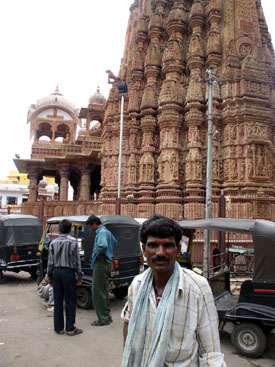 Jhalawar temple is strange in its form. A shikhara and jagmohan keep it within the acceptable limits and vocabulary of the archetypical north Indian Hindu temple, but it's a mish-mash of sorts, incorporating elements that have no business being here with others. Here there is a Gujarati torana, that goes with the intricacy of the ceiling but not with the shikhara. A first floor with a terrace (!) challenges all notions of what a temple is, and is used for. I later learn that this mix-and-match is characteristic of many temples that we will later see. And in retrospect, this is not so unreasonable. When Rajput art and palaces borrow heavily from Mughal examples and fuse styles together, why should one expect religious architecture to be any different? Here, in this little town, this little lesson in aesthetic fusion is brought home.
Jhalawar temple is strange in its form. A shikhara and jagmohan keep it within the acceptable limits and vocabulary of the archetypical north Indian Hindu temple, but it's a mish-mash of sorts, incorporating elements that have no business being here with others. Here there is a Gujarati torana, that goes with the intricacy of the ceiling but not with the shikhara. A first floor with a terrace (!) challenges all notions of what a temple is, and is used for. I later learn that this mix-and-match is characteristic of many temples that we will later see. And in retrospect, this is not so unreasonable. When Rajput art and palaces borrow heavily from Mughal examples and fuse styles together, why should one expect religious architecture to be any different? Here, in this little town, this little lesson in aesthetic fusion is brought home.
The rest of Jhalawar, including the fortress on a hillock, is singularly uninspiring. What is of more interest are a group of temples near the town.
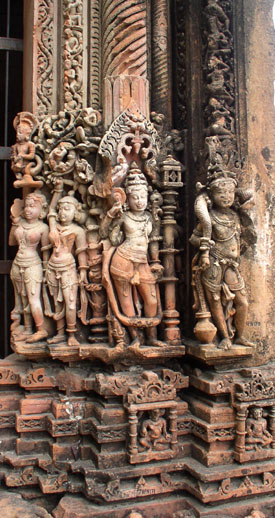 The main shrine is a fusion of elements, with pillars, ceiling work, and a strange, misshapen crumbling dome clearly additions and alterations at different times.
The main shrine is a fusion of elements, with pillars, ceiling work, and a strange, misshapen crumbling dome clearly additions and alterations at different times.
There are two small shrines behind this temple, elegant works of art with exquisite carving climbing sinuously up their facades, motifs that do not seem to belong, an almost South-East Asian iconography of form and icon that looks out of place in Jhalawar.
The ride back is in silence, with even the driver tired, it seems, his early ardour cooled down. It is evening by the time we reach Kota.
Dinner at Akshay's place is a mix of excellently spiced food and even spicier conversation.
Kota's elder sister-in-law is an attractive woman whose sharp conversation makes her a potentially really interesting person. Kids run around all over the floor mingling with a large locust that Akshay crushes mercilessly.
We sleep on the floor on two mattresses lined up together, a difficult sleep in the heat, mosquitoes and anticipation of waking early in the morning.
17-Sep-2006
More by : Ashish Nangia